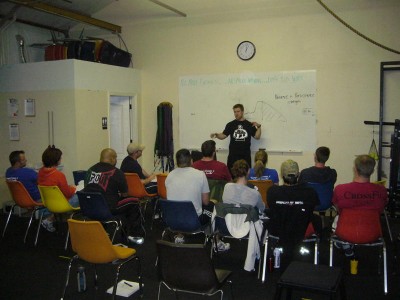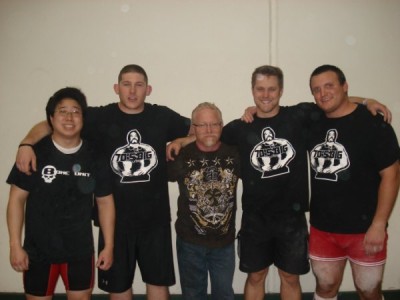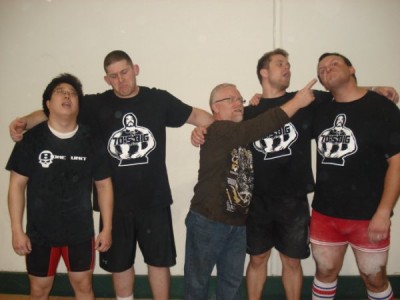I’ll be the first to admit that I don’t know something, and something that I don’t know a whole lot about is grip strength. However, I have a few pointers that may help you include it in your training.
Brent mentioned Chris’ impressive hook grip, but Chris is not the only person to implement a double overhand hook grip (DOHG).Brad Gillingham pulling 881 DOHGY style.
The ease of being able to hold onto a deadlift is dependent on your grip strength, but, as with all of lifting, it is dependent on your anthropometry as well. The anthropometry in question is the total hand size, palm size, and finger length. Larger hands will make deadlifting easier because the circumference of the bar is relatively smaller. On the other hand, smaller hands will make holding onto a bar more difficult because it is analogous to a larger handed man deadlifting with a fat bar (or at least a “fatter bar”). This is the same reason why women’s weightlifting bars are of a smaller circumference of men; they have smaller hands.
This is another reason why not everyone can implement the hook grip; they may not have the hand size to successfully do so. Chris is one of those guys who has some large hands (he calls them “his grips”), and for some reason his thumbs aren’t damaged by the hook grip (we’ll get to this later). Brent, on the other hand, is a 5’5” Korean who has hands like a child. If he is capable of DOHGing his max deadlift, which I don’t think he is, then he will have to work very hard towards that goal.
Total hand size is then broken down into two characteristics: palm size and finger size. Someone can have decently sized hands, but then have shorter fingers with large palms (this describes my hands). In contrast, someone can have very long fingers with a smaller palm area. I’m not sure if this poses a problem for holding onto a barbell – it would seem like it would be the ideal situation.
Now let’s say you have some decently sized hands and you still can’t make DOHG work. In this case, your thumbs probably hurt like a mofo when you try it. Well, as with most things, you’ll have to get adapted to it. Chris was an Olympic weightlifter before he got into powerlifting, so he was comfortable early on with the hook grip. When he trained his deadlift, he naturally used the DOHG. I would even surmise that he used it when he was weaker, and as he got stronger he continued using the DOHG. I know that in the time that I have coached him and trained with him his deadlift has gone from the mid 400’s for reps to the low to mid 600’s – all with a DOHG. This means that A) his hand size permitted him to use the DOHG and B) his DOHG strength adapted with his pulling strength.
But is the DOHG any more impressive than an alternated grip? I guess since the hands are both pronated it makes the rep look more awesome. But remember, the hook grip is used so that A) grip strength isn’t a factor in the lift and B) it allows the grip muscles (that cross the wrist while some also attach at the elbow) to relax and allow the wrist and elbow to pass through their ranges of motion more easily when doing the snatch or the clean. Since these muscles are not all contracting, it makes holding onto the bar easier. Regarding the deadlift, it also prevents any of the imbalances that can occur from having one forearm supinated (whether it be mechanical or anatomical problems). In other words, it makes the deadlift more efficient and safe, and this is why you should use it if you can. But does that mean it’s more impressive? I don’t know. It may be that Chris will need to switch to an alternated grip when his deadlift gets heavier (we have talked about this), but I don’t think he’ll need to. Time will tell as his career progresses.
Regarding grip strength in general, it usually isn’t something a novice should be worrying about. Pull your deadlift warm-ups with an overhand grip and it will improve over time. If you’re able to DOHG it, go ahead, but otherwise alternate your grip when necessary. Both of these methods will still improve your grip strength, although I don’t know by how much. The alternated grip will require the finger flexors to work much harder than in the hook, but this may not be more of a detriment. Remember that an alternated grip makes the bar easier to hold onto because your hands apply torque to the bar in two different directions. This prevents the bar from rolling in any one direction as your hands weaken and probably improves the coefficient of friction as a result.
If you are unable to keep a hold on your deadlifts regardless of the method, then you are probably underweight. Double check this fact by stepping on the scale, and once you are sure, absolutely positive you are a strapping adult male, then we’ve got some weird problems because most decently sized guys can hang onto decent amounts of weight. Nevertheless, we need you to get stronger ASAFP. If you limit your deadlift because you can’t hang onto the bar, then you are also limiting your squat, your muscle mass increases, your hormones from going all crazy to help you grow, and thus you’re indirectly affecting your other lifts. Obviously you need to use straps. You need to be strong NOW.
But they don’t allow straps in meets, so you’ll have to get this shit figured out soon if you’re wanting to compete. In which case you go to the grip gurus and ask them – that ain’t me (Gant will be writing an article for this soon, so be patient). Sure, it’d be great to have your cake (the big deadlift) and eat it too (no straps), but you may be deficient in one of those areas. Get strong, and then worry about the grip later.
—–
I wouldn’t say the “no straps subculture” (how the hell did we start calling this a subculture, Brent?) is like the “no belts subculture”. The “no belts” guys are just stupid and/or ignorant and usually not very strong. The “no straps” guys are usually veteran lifters who are pretty damn strong. Don’t confuse the two, and don’t insult the “no straps” guys.
But even “no straps” guys would have to agree that they have their use. If you are pretty damn strong in the rack pull, then you will run into a grip problem. There are guys that can rack pull hundreds of pounds more than they can deadlift. If your grip is the limiting factor on an assistance exercise, then you better use straps to allow the relevant muscles to bear the load (erectors of the back, lats, hamstrings, etc.). Not to mention that it is preferable to use an overhand grip in pulling assistance exercises (like rack pulls, halting deadlifts, stiff legged deadlifts, Romanian deadlifts, etc.) because it works the muscles in symmetry and also prevents any asymmetry related injuries to occur (e.g. straining or tearing a biceps tendon).
Regarding Brent’s inquiries about Kroc Rows and wearing a shirt, I’ll let my friend Mike comment on the rows tomorrow. But for fuck’s sake, keep your shirt on if you’re in a gym you don’t own.



